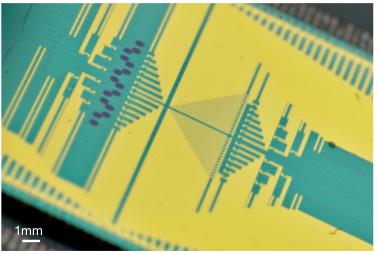Scaling silicon quantum photonics technology

A large-scale integrated silicon-photonic quantum circuit for controlling multidimensional entanglement. Graphic: from the original publication
Now a team of researchers from the University of Bristol, Peking University, Technical University of Denmark, ICFO Spain, PAS, University of Copenhagen and Dr. Jordi Tura from the Theory Division at the Max Planck Institute of Quantum Optics has developed a large-scale integrated silicon-photonics quantum circuit for the precise and general control of multidimensional entanglement.
Integrated Quantum Photonics allows the routing and control of single particles of light with intrinsically high stability and precision, however to date it has been limited to small-scale demonstrations in which only a small number of components are integrated on a chip. It is thus in high demand to scale up the integrated photonic circuits and increase the complexity and computational power of modern quantum information processing technologies that would enable many revolutionary applications.
An international team of researchers led by scientists from the Uni. of Bristol’s Quantum Engineering Technology Labs has demonstrated the first ever large-scale integrated quantum photonic circuit, which can generate, control and analyze high-dimensional entanglement with unprecedented high precision and generality. The quantum chip was realised using a scalable silicon photonics technology, similar to today’s electronic circuits, which would provide a path to manufacture massive components for the realization of a optical quantum computer.
The work, in collaboration with Peking University, Technical University of Denmark (DTU), Institut de Ciències Fotòniques (ICFO), Polish Academy of Sciences (PAS), University of Copenhagen and the Theory Division at the Max Planck Institute of Quantum Optics (MPQ), has been published online by the journal Sience (8 March 2018).
Coherently and precisely controlling large quantum devices and complex multidimensional entanglement systems has been a challenging task owing to the complex interactions of correlated particles in large quantum systems. Significant progress towards large-scale quantum systems has been recently reported in a variety of platforms including photons, superconductors, ions, dots and defects. In particular, photonics represent a system able to naturally encode and process multidimensional qudit states in photon’s different degrees of freedom.
In this work, a programmable bipartite path-encoded multidimensional entangled system with dimension up to 15×15 is demonstrated, where each photon exists over 15 optical paths at the same time and the two photons are entangled with each other there. This multidimensional entanglement system is achieved by scaling up the silicon-photonics quantum circuits via a single chip integration of 550 optical components including 16 identical photon-pair sources, 93 optical phase-shifters, 122 beam-splitters, among other optical elements.
Lead author, Dr Jianwei Wang, said: “It is the maturity of today’s silicon-photonics that allows us to scale up the technology and reach a large-scale integration of quantum circuits. This is the most beautiful thing of quantum photonics on silicon. As a result, our quantum chip allows us to, for the first time, reach the unprecedented high precision and universality of controlling multidimensional entanglement, a key factor in many quantum information tasks of computing and communication.”
Dr Yunhong Ding from DTU added: “New technologies always enable new applications. The capabilities of our integrated technology allow us to observe high-quality multidimensional quantum correlations including generalized Bell and EPR steering violations, and also to implement experimentally unexplored multidimensional quantum protocols: multidimensional randomness expansion and state self-testing.”
Dr Jordi Tura from MPQ stated: “The degree of precision and control achieved with this technology has allowed us to test it against some of the most stringent quantum information protocols, such as self-testing or randomness expansion, which are possible only under very idealized experimental conditions.”
Professor Mark Thompson, the PI of the Bristol team, said: “The photonic circuits on silicon, the same material as used in our electronic circuits, allow the processing of information carried by a single particle of light. This silicon quantum photonics technologies are allowing us to scale up quantum devices and systems in an incredibly rapid speed, and in near future it would reach an integration of tens of thousands of elements on a single chip that can promise numerous quantum applications.”
Original publication:
J. Wang, S. Paesani, Y. Ding, R. Santagati, P. Skrzypczyk, A. Salavrakos, J. Tura, R. Augusiak, L. Mancinska, D. Bacco, D. Bonneau, J. W. Silverstone, Q Gong, A. Acin, K. Rottwitt, L. K. Oxenløwe, J. L. O’Brien, A. Laing, and M. G. Thompson
Multidimensional quantum entanglement with large-scale integrated optics
Science 08 Mar 2018: eaar7053, DOI: 10.1126/science.aar7053
Contact:
Dr. Jordi Tura i Brugués
Max-Planck-Institut für Quantenoptik
Hans-Kopfermann-Str. 1
85748 Garching b. München
Telefon: +49 (0)89 / 32 905 -346
E-Mail: jordi.tura@mpq.mpg.de
Prof. Dr. J. Ignacio Cirac
Honorarprofessor TU München und
Direktor am Max-Planck-Institut für Quantenoptik
Hans-Kopfermann-Straße 1
85748 Garching b. München
Telefon: +49 (0)89 / 32 905 – 705
E-Mail: ignacio.cirac@mpq.mpg.de
Dr. Olivia Meyer-Streng
Presse- und Öffentlichkeitsarbeit
Max-Planck-Institut für Quantenoptik
85748 Garching b. München
Telefon: +49 (0)89 / 32 905 -213
E-Mail: olivia.meyer-streng@mpq.mpg.de
Media Contact
More Information:
http://www.mpq.mpg.de/All latest news from the category: Physics and Astronomy
This area deals with the fundamental laws and building blocks of nature and how they interact, the properties and the behavior of matter, and research into space and time and their structures.
innovations-report provides in-depth reports and articles on subjects such as astrophysics, laser technologies, nuclear, quantum, particle and solid-state physics, nanotechnologies, planetary research and findings (Mars, Venus) and developments related to the Hubble Telescope.
Newest articles

NASA: Mystery of life’s handedness deepens
The mystery of why life uses molecules with specific orientations has deepened with a NASA-funded discovery that RNA — a key molecule thought to have potentially held the instructions for…

What are the effects of historic lithium mining on water quality?
Study reveals low levels of common contaminants but high levels of other elements in waters associated with an abandoned lithium mine. Lithium ore and mining waste from a historic lithium…

Quantum-inspired design boosts efficiency of heat-to-electricity conversion
Rice engineers take unconventional route to improving thermophotovoltaic systems. Researchers at Rice University have found a new way to improve a key element of thermophotovoltaic (TPV) systems, which convert heat…



